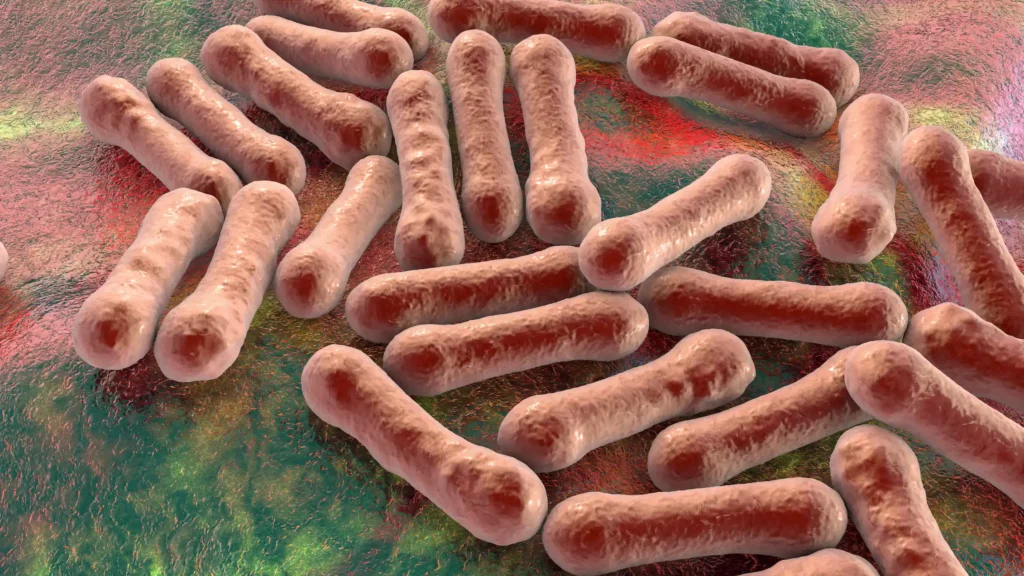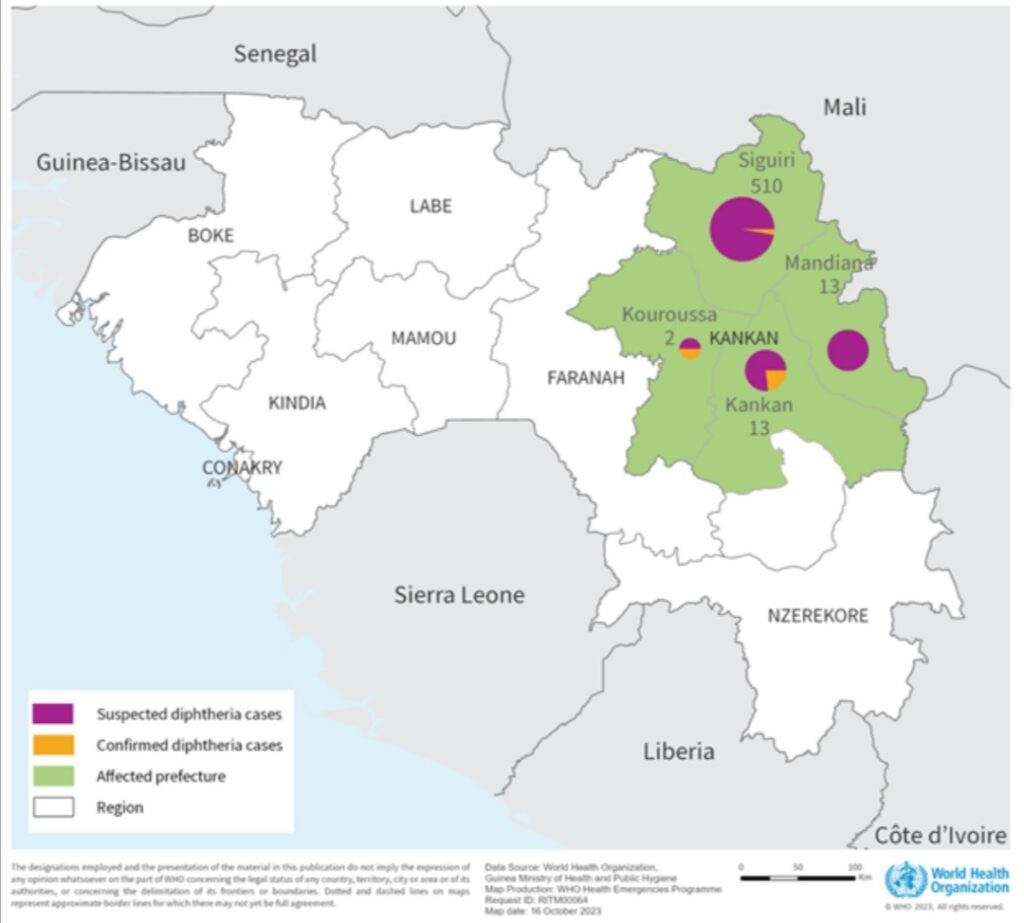WHO Announces New Disease Outbreak

Diphtheria

SPONSORED
By WHO Media Team
On 5 September 2023, the Ministry of Health notified WHO of a diphtheria outbreak in Guinea. From 4 July to 13 October 2023, a total of 538 cases of diphtheria, were reported in the Kankan region, in the east-central part of Guinea.
Of the total cases reported, 520 are suspected and 18 confirmed with 58 deaths including 13 among confirmed cases (case fatality rate (CFR) among all cases, 11%).
The 1-4 years age group accounted for the largest proportion of reported cases. Diphtheria is a highly contagious vaccine-preventable disease caused mainly by the bacteria Corynebacterium diphtheriae which can be fatal in 5-10% of cases, with a higher mortality rate in young children.
However, in settings with poor access to diphtheria antitoxin, the CFR can be as high as 40%. Diphtheria remains a significant health problem in countries with poor routine vaccination coverage.
According to WHO/UNICEF estimates of national immunization coverage (WUENIC), the immunization coverage with the diphtheria tetanus toxoid and pertussis (DTP3) containing vaccine was reported to be 47% for 2022 in Guinea and has remained below 50% since 2014.
This is insufficient for achieving the coverage of 80–85% required to maintain community protection. WHO assesses the risk of 80–85% required to maintain community protection.
WHO assesses the risk of diphtheria to be high in Guinea, considering the chronically low vaccination coverage.
Description of the Situation
On 5 September 2023, the Ministry of Health notified WHO of the current diphtheria outbreak in Guinea.
On 4 July 2023, two children aged 2 and 4 years, attended the otolaryngology department of the Siguiri prefectural hospital in the Kankan region of Guinea, for similar symptoms (dyspnea, dysphasia, fever, cough).
They were hospitalized for tonsillitis and respiratory infection and received antibiotic treatment before being referred to the Kankan regional hospital for additional care.
Since 4 July and as of 13 October 2023, 538 cases have been reported, including 18 confirmed cases.
In total, 58 deaths including 13 among confirmed cases were registered (case fatality rate (CFR) among all cases, 11%)., and 461 contacts are being followed up.
Of the cases reported, 62% are female. The 1-4 years age group, with 445 cases, accounted for the largest proportion of reported cases, 82%, followed by the 5-9 years age group, with 5% and 5% for the 10 years and above age group.
Children under the age of 12 months make up 7% of reported cases. None of the 538 cases were vaccinated.
Kankan Region is divided into five prefectures and only the Kérouané prefecture has not reported any cases to date.
The prefecture of Siguiri is the most affected, with 510 cases (95%). Of the 363 patients admitted to the treatment centers in Siguiri, 37 (10%) have died.
Other prefectures reporting cases are Mandiana (13 cases), Kankan (13 cases) and Kouroussa (two cases). Of the 15 patients admitted in the treatment center in Kankan, 12 (80%) have died.
The treatment centers in the country do not have the capacity in terms of human resources and material for adequate case management.
Suspected and confirmed cases were treated with Amoxicillin and Azithromycin as first line therapy. Antibiotic prophylaxis (Amoxicillin, Azithromycin) was administered to the direct contacts.

Figure 1: Distribution of diphtheria cases in Kankan region, Guinea, as of 13 October 2023

Figure 2: Suspected diphtheria cases by epidemiological week in Guinea, as of 13 October 2023
Epidemiology
Diphtheria is a highly contagious vaccine-preventable disease caused mainly by Corynebacterium diphtheria but also by Corynebacterium ulcerans.
It spreads between people mainly by direct contact or through the air via respiratory droplets. The disease can affect all age groups; however, unimmunized children are most at risk.
Symptoms often come on gradually, beginning with a sore throat and fever. In severe cases, the bacteria produce a poison (toxin) that causes a thick grey or white patch at the back of throat.
This can block the airways, making it hard to breathe or swallow, and also creates a barking cough. The neck may swell in part due to enlarged lymph nodes.
Treatment involves administering diphtheria antitoxin (DAT) as well as antibiotics.
Vaccination against diphtheria has been effective in reducing the mortality and morbidity from diphtheria dramatically.
Diphtheria is fatal in 5-10% of cases, with a higher mortality rate in young children. However, in settings with poor access to DAT, the CFR can be as high as 40%.

SPONSORED
Public Health Response
- Guinea has strengthened epidemiological surveillance for early detection and case management.
- Daily coordination and monitoring meetings on the response activities are underway at the Regional level, led by the regional health inspector and with the support of WHO, MSF- Belgium and other partners in the region.
- Notification of all suspected cases of diphtheria, investigation initiation, and monitoring of contacts as soon as possible has been enhanced.
- Contact tracing, identification of an isolation zone at the Balato health post in the prefecture of Kouroussa and briefing of the healthcare workers on the case definition and prevention measures are ongoing.
- Case management activities such as antibiotic therapy (Amoxicillin, Azithromycin), treatment of suspected cases, antibiotic prophylaxis (Amoxicillin, Azithromycin) for the direct contacts and free case management at treatment centers with support from MSF are provided.
- Risk communication and community engagement efforts, such as raising awareness of cases in the community and identifying and briefing a communicator to raise awareness among parents of patients is ongoing.
WHO Risk Assessment
Diphtheria is a vaccine-preventable disease caused by exotoxin-producing Corynebacterium diphtheriae, transmitted from person to person through close physical and respiratory contact.
It can cause infection of the nasopharynx, which may lead to breathing difficulties and death. Diphtheria is fatal in 5 – 10% of cases, with a higher mortality rate in young children.
Treatment involves administering diphtheria antitoxin as well as antibiotics. Vaccination against diphtheria has reduced the mortality and morbidity of diphtheria dramatically.
The DAT supply is currently very constrained and insufficient to respond to current demands, as there is only a limited number of manufacturers and large outbreaks are being reported in different regions of the world.
The risk of diphtheria in Guinea is considered high due to the low DTP3 vaccination coverage in the affected region (36% according to the survey coverage in households, 2023) and 47% national DTP3 vaccination coverage between 2014-2022 (per WHO/UNICEF estimates), and the risk at the regional level is moderate and low at the global level. T
he outbreak is also characterized by high case fatality among confirmed cases. Other factors include: the over population of the Siguiri health district, which is the epicenter of this outbreak, the weakened healthcare system and several concurrent epidemics in the area.
The overpopulation of the Siguiri health prefecture, the epicenter of this epidemic, the insufficient poorly qualified health personnel, and the limited material resources of the health system weakens the response to this outbreak.
In addition, the country is facing several concurrent epidemics in the area, such as pertussis, poliomyelitis, and rabies.
Adding this to a context of extreme vulnerability due to mining activities, which induce significant population movement, reduce air quality, and increase the risk of natural disasters such as floods and landslides, impacting people’s health.
This emphasizes the urgent need to strengthen diphtheria vaccination coverage nationwide, especially in the epicenter and strengthen case management at hospital facilities dealing with diphtheria cases.
WHO Advice
The control of diphtheria is based on primary disease prevention by ensuring high population immunity through vaccination and secondary prevention of spread by the rapid investigation of close contacts to ensure prompt treatment of those infected.
Epidemiological surveillance ensuring early detection of diphtheria outbreaks should be in place in all countries, and all countries should have access to laboratory facilities for reliable identification of toxigenic C. diphtheriae.
Adequate quantities of diphtheria antitoxin should be available nationally or regionally for the medical management of cases.
Vaccination is vital to preventing cases and outbreaks, and adequate clinical management involves administering diphtheria anti-toxin to neutralize the toxin and antibiotics reducing complications and mortality.
WHO recommends early reporting and case management of suspected diphtheria cases to initiate the timely treatment of cases and follow-up of contacts and ensure the supply of diphtheria antitoxin.
WHO advises implementing the following Infection Prevention & Control (IPC) measures in health care settings:
At screening/triage, immediately place patients with symptoms of Upper Respiratory Tract Infection (URTI) in a separate area until examined, and, if a probable case, cohorted with patients with the same diagnosis.
Keep the isolation area segregated from other patient-care areas.
In addition to using standard precautions, patients with known or suspected respiratory diphtheria are placed under droplet precautions.
Patients with known or suspected cutaneous diphtheria should be placed under contact precautions. Maintain one meter between patients. Keep patient care areas well- ventilated. Avoid patient movement or transport out of the isolation area.
If movement is necessary out of the isolation area, have the patient use a medical mask and cover any wounds/lesions on the patient’s body.
Case management should be carried out following the WHO guidelines.
In addition, high-risk populations such as young children under five years of age, school children, the elderly, close contact with diphtheria cases, and healthcare workers should be vaccinated on a priority basis.
A coordinated response and community engagement can support further transmission and control of the ongoing outbreak.
Prophylactic antibiotics (penicillin or erythromycin, dependent on the isolate antibiotic sensitivity) are indicated for close contacts for seven days.
If the culture is positive for toxigenic Corynebacterium spp.., the contact should be treated as a case with an antibiotic course for two weeks (DAT is not needed for asymptomatic cases or cases without a pseudo membrane).
Although travelers do not have a particular risk of diphtheria infection, it is recommended that national authorities remind travelers going to areas with diphtheria outbreaks to be appropriately vaccinated in accordance with the national vaccination scheme established in each country before travel.
A booster dose is recommended if more than five years have passed since their last dose.
WHO does not recommend that any general travel or trade restrictions be applied to Guinea based on the information available for this event.









WHO Announces New Disease Outbreak | midwestherald
ojwqvqknln http://www.gxkzq4dia624964b364seq41g8g05lk1s.org/
[url=http://www.gxkzq4dia624964b364seq41g8g05lk1s.org/]uojwqvqknln[/url]
aojwqvqknln
CNC Machining Cylinder Parts
Hirschmann plug
CNC Machining Parts
rep kickmax shoes adidas Campus 00s “Bark” sneakers
Mach102
rep travis scott golf reps adidas Adifom Superstar sneakers
Spline Sleeve Parts
cheap kickmax ru adidas x Kith Samba “White Grey Gold” sneakers
west.com.do
Moxa e1210
CNC Machining Assembly
rep kickmax adidas Yeezy YEEZY 450 “Stone Teal” sneakers
Brs30 hirschmann
cheap kickmax.ru shoes adidas YEEZY Foam Runner “Stone Taupe” sneakers
Hirschmann
Custom Made Fastener
Glass Jars With Lids
Stainless Steel Investment Casting
Luxury Lotion Bottle
cheap christian dior tote price TOP-Small Lady Dior Bag Wicker and Oblique Motif Canvas Black
cheap mini dior book tote TOP-Medium Dior Boston Bag Box Calfskin Black
Packaging For Cosmetics
Cosmetics Packaging Containers
Deep Drawing
cheap vintage dior earrings TOP-Small Miss Dior Top Handle Bag Cannage Lambskin Black
Deep Drawing & Spinning
Elevator Door Pulley
Casting
http://www.rwopr.pl
Cosmetic Packaging Eco Friendly
cheap j adior bag TOP-Medium Lady D-lite Bag Butterfly Around The World Motif Canvas White Gold
cheap christian dior black purse TOP-Medium Lady D-lite Bag Plan de Paris Motif Canvas Black
affordable replica horloges Swiss Designer J12 Automatic Ladies Watch
http://www.tbgfrisbee.no
Juicy Disposable Vape
Best Vape
Vape Disposable
Little Shingle Ripper
Disposable E Cigarette
Ladder Mount
affordable cartier ballon bleu fake vs real Breitling Colt Chronograph II Black Dial Stainless Steel Bracelet 622427
rep repwatch forum Designer G-Timeless 38mm Unisex Watch YA1264067
Ecigs
Grandy Bread Box
Support Bracket
cheap reptimebst Swiss Designer Boy-Friend Ladies Watch
cheap datejust replica Swiss Breitling Navitimer 41mm Automatic A17326211G1A1
Block Holder
Pvc Coated Clearvu Anti Climb Fence
U Bolt
Spannring Schnellverschluss
Quick Release Connector for Clamping Rings
affordable gucci shoes for men cheap 2024 WINTER Clothing 2409BL0116
cheap gucci shoes for women cheap 2024 WINTER Clothing 2409BL0124
evoressio.com
Anti Climb Security Fence
ODM/Patented Products
No Climb Fence
Climb Fence
affordable gucci shoes for cheap china 2024 WINTER Clothing 2409BL0122
affordable gucci shorts mens cheap 2024 WINTER Clothing 2409BL0079
cheap gucci shoes for kids/boys cheap 2024 WINTER Clothing 2409BL0117
Spannring Parts
High Security 358 Fecne
affordable cheap gucci socks CL BROOCH
Pneumatic Actuator
Agriculture Machinery OEM Parts
Modern Led Outdoor Camping Lanterns Crystal Desk Lamps
Pneumatic Reed Switch
Fisher Smart Positioner
affordable cheap gucci sunglasses VERSACE NECKLACE
Air Filter Pressure Regulator
remasmedia.com
Sheet Metal Fabrication
Automotive Adjustable Torsion Bar
Sheetmetal Automotive OEM Parts
cheap cheap gucci suits CL BROOCH
cheap cheap gucci sneakers mens CL BROOCH
Pressure Switch Hvac
cheap cheap gucci sweater men CL HAIR CLIP
USB Change Touch Silicone Birthday Night Cake Table Lamp
Study Foldable Rotatable Desk Lamp Touch Switch Table Lamp
Wholesale Sleeveless Dress
Swimwear
cheap chanel perfume cheap SCARVES scarves 2410SC0210
Relaxing Mushroom Kids New Modern Led Cloud Table Lamp
Mens Tracksuits Set
Mini Bedroom Night Light Cute Design Dinosaur Table Lamp
cheap chanel cheap clothes SCARVES scarves 2410SC0190
cheap chanel earrings cheap SCARVES scarves 2410SC0157
casual shirts for women
Clip Study Light Usb Rechargeable Bedroom Clip-On Table lamp
affordable chanel cheap items SCARVES scarves 2410SC0161
Jackets & Vests
drum.arsnova.com.ua
affordable chanel for cheap SCARVES scarves 2410SC0171
Multistage Centrifugal Pump
Silent Cooling Fan
Gaming Mechanical Keyboard And Mouse Combo
Silent Wired Keyboard
Industrial Booster Pump
soonjung.net
Horizontal Multistage Centrifugal Pump
Commercial Water Pump
Small Cooling Fan
Display Water Cooler
affordable foot locker outlet store FF Dunk High Retro Premium 'Gold Canvas'
Water Pump Pressure Switch
affordable foot locker outlet mall FF Dunk High Retro 'Bruce Lee'
cheap foot locker outlet locations FF Dunk High Retro 'Blue Chill'
cheap foot locker outlet shop FF Dunk High Retro 'Obsidian'
affordable foot locker factory outlet FF Dunk High Retro 'Black White'
rep m126710blnr 0002 Swiss Cartier Ballon Bleu White Dial Stainless Steel Case Steel Bracelet 622672
Laxcido 4g Watch
cheap copy designer watches Cartier Ballon Bleu Silver Bezel with Green Dial and Green Leather Band 621553
cheap ap replica watches Cartier Tank Anglaise 36mm White Dial Stainless Steel Case Two Tone Bracelet
Fall Detection Smart Watch
toyotavinh.vn
rep bezelar Cartier Ballon Bleu 42mm White Dial Diamonds Pink Gold Case And Bracelet
Swimming Watch
Wall-Mounted Display Stand
Bathroom Water Pipe Display Stand
affordable rolex swiss clone Cartier Tortue Large Date White Dial Gold Case Brown Leather Strap
Floor Tile Wall-Mounted Display Stand
Step Counter Watch Ladies
Smart Watch
Real Stone Paint Rotating Display Stand
Mosaic Drawer Display Stand
Canoe Anchor
Hot Dipped Galvanized Pipe Tube
Torsion Bar Support
cheap cheap gucci clothes for women's Dio Bags 2410YA0081
cheap cheap gucci clothes Bottega Veneta Bag 2108SF0300
http://www.nunotani.co.jp
bluetooth barcode scanner android
affordable cheap gucci clothes for womens Dio Bags 2406YA0011
Roof Harness Mount
affordable cheap gucci clothes for mens online Dio Bags 2410YA0047
Manual Pipe Bending Machine
N1 Adjustable Push Rod
rugged handheld devices
N2 Adjustable Push Rod
Gi Pipe Tube
affordable cheap gucci by gucci perfume Dio Bags 2406YA0010
Variable Power Supply
glimsc.xsrv.jp
affordable cheap coco chanel earrings LV Bags 2407YZ0078
Pulse Reverse Power Supply
Leather Floor Display Stand
Programable Power Supply
cheap cheap coco chanel purses LV Bags 2407YZ0025
cheap cheap coco chanel bags LV Bags 2407YZ0026
Floor Display Stand
Curtain Floor Display Stand
Wallpaper Display Stand
Power Supply 30v
affordable cheap chanel wallet LV Bags 19T1L0635
affordable cheap dior LV Bags 2407YZ0079
Floor Display Racks
High-Voltage Dc Power Supply
Acid-Resistance Rubber Sheets KNS200
Acid-Resistance Rubber Sheets
Acid-Resistance Rubber Sheets KNS350
Fiber Network Cable
Drop Fiber Cable
abam123456.tempurl.co.il
cheap adidas order tracker Jordan Air Jordan 5 Low “Class Of 2021” sneakers WOMEN
cheap premium outlets hagerstown md Jordan Air Jordan Mid 1 “Multicolor Swoosh” sneakers WOMEN
affordable norfolk outlet mall stores Jordan Jordan ADG 3 sneakers WOMEN
cheap norfolk outlets stores Jordan Air Jordan 12 Retro “Vachetta Tan” sneakers WOMEN
Asbestos Rubber Sheet with wire net strengthening
DHD380
Guy Grip Dead End Factory
affordable stores at the monroe outlet Jordan Air Jordan 12 “CP3 Class Of 2003” sneakers WOMEN
Montabert
Acid-Resistance Asbestos Rubber Sheets
affordable cheap gucci crossbody bags Gucci Bag 2204YA0060
PTFE ROD
PEEK
Foot control switch
cheap cheap gucci crossbody bag Gucci Bag 2204YA0025
http://www.adentech.com.tr
Disc Granulation Pellet Binder
X Ray Hand Switch
ABS
Acid Pellet Binder
ABS Sheet
Processing Product
affordable cheap gucci cologne Gucci Bag 2308DJ0050
High Voltage Ethernet Cable
affordable cheap gucci clothes for womens Gucci Bag 2205YA0038
cheap cheap gucci coats Gucci Bag 2209DJ0032
Круглая Щётка С Подогревом
http://www.mesopotamiarestaurant.gr
Washing Machine Dryer Electric Makeup Brush Cleaner
Полотенца С Капюшоном Для Взрослых
7 in 1 Professional 1 Step Hair Dryer Brush Volumizer Hair Curler
Hot Sale Ceramic Electric LED Long Barrels Self Curling Iron
cheap chanel cheap clothes FENDI BAGUETTE-26*15*4cm
Промышленная Швабра
Шторка Для Ванной
cheap chanel earrings cheap FENDI BAGUETTE-20*5*13CM
affordable chanel for cheap FENDI BAGUETTE-26*13*6CM
Hair Roller Curler Crimper Hair Iron Big Barrel Curling Iron
Professional 6 IN 1 multi styler and hairdryer Curler Styling Tools
affordable chanel cheap items FENDI BAGUETTE-26*13*6CM
Пароочиститель Для Затирки
affordable chanel cheap FENDI BAGUETTE-26*13*6CM
Cooler Can
Flexible Graphite Sheet rolls
Expanded PTFE Sheet
cheap how much is a hermes kelly bag Hermes Birkin Touch Bag Alligator & Togo Leather Palladium Hardware In Black
Cooling Tower Fill
affordable brown hermes bag Hermes Birkin 40 Bag Togo Leather Palladium Hardware In Grey
Cooling Water Tower
abilitytrainer.cloud
cheap blue birkin bag hermes Hermes Birkin Faubourg Bag Alligator & Epsom Leather Palladium Hardware In Blue
Advance Cooling Tower
affordable antique hermes bag Hermes Birkin Faubourg Bag Alligator & Epsom Leather Palladium Hardware In Black
Cork Sheet
cheap clemence hermes bag Hermes Birkin Bag Epsom Leather Gold Hardware In Black
Nuclear grade Flexible graphite sheet
Cork Rubber Sheet
Cooling Tower Fans
luxury bag brands in the world VALENTINO MULES
Mini Nano Face Moisturizer Skin Care Women Facial Sprayer
Pole Dancing Shoes
Ankle Sandals Flat
hp-test.merchant-s.com
Dolphin Coral Fleece Absorbent Cartoon Hanging Towel
Face Steaming Device Nano Steam Professional Facial Steamer
Best Ballerina Flats
Bespoke Women Shoes
most popular louis vuitton bags 2022 HERMES SANDAL
New Baby Square Plush Bath Baby Hand Animal Hanging Towel
luxe hd handbags GUCCI SLIDE SANDALS
Best Ballerina Shoes
Portable Nano Hydrogen Water Facial Mist Electric Spray
louis vuitton stockists near me HERMES SANDAL
louis vuitton bag noir HERMES SANDAL
uv 8d
baofeng dmr radios
motorola two way radios
m37 icom
cheap 2024 chanel price increase HOT SALE-CHANEL 2013-2014 Caviar Grand Shopping tote bag Women
mototrbo two way radio
http://www.fines.co.jp
affordable vintage chanel bracelet HOT SALE-CHANEL 2014-2015 Quilted Aged Calfskin Single Flap shoulder bag Women
USB Magnetic Wooden Levitation Mid-air Balance Desk Lamp
cheap chanel clip on earrings vintage HOT SALE-CHANEL 2004-2005 medium Double Flap shoulder bag Women
affordable camera bag chanel vintage HOT SALE-CHANEL 1998 medium Double Flap shoulder bag Women
cheap chanel chevron HOT SALE-CHANEL 2005-2006 Caviar Medallion tote bag Women
Modern Style Outdoor Usb Cordless Bedside Folding Desk Lamp
Bar Table Led Touch Sensor Retro Desktop Dumbbell Desk Lamp
Nordic Antique Luxury Stained Glass Vintage Tiffany Desk Lamp
Farmhouse Drum Contemporary Ceramic Stone Desk Lamp
Gray Hard PVC Rod Dark Gray PVC Bar
Hot sale $1000 lv bag HOT SALE-LV Belts 2210XA0080
High Quality PVC Panel
Garage Bug Zapper
Humane Mouse Trap
http://www.kinnikubaka.com
Acid alkali Moth PVC Panel in Guangzhou
Hot sale louis vuitton outlet deal HOT SALE-LV Bag 2209DJ0001
Hot sale louis vuitton outlet deal HOT SALE-LV Belts 2210XA0085
Bug Zapper Lantern
Heat-resistant soldering pallet material fiberglass durostone sheet
Electric Bug Trap
Perspex Resin plastic PVC sheet
Hot sale $1000 lv bag HOT SALE-LV Bag 2304DJ0025
Hot sale $1000 lv bag HOT SALE-LV Belts 2301XF0025
Repellent Mosquito Bracelet
Floor Mount Tv Stand
Wall Mount Tv Bracket
affordable really cheap gucci belts Louis Vuitton Dauphine MM(2019 Spring Show)
Chemical Intermediate
Fine Chemicals
Medicines And Pesticides Intermediate
Tv Stand Easel
Perfluoro n-butylsulfonylfluoride
cheap real gucci belt cheap Louis Vuitton Dauphine Mini(2019 Spring Show)
http://www.sp-plus1.com
Under-Desk Pc Mount
Computer Stand
rep reddit is the gucci store cheap in italy LOUIS VUITTON DAUPHINE MM
cheap shop cheap louis vuitton handbags under $100 LOUIS VUITTON FAVORITE
rep louis vuitton wallet cheap Louis Vuitton Belt Bag(2019 Spring Show)
Functional Fine Chemical Material
Electrical insulation drilling and tapping FR4 sheet for PCB
bib and brace workwear
rain coats women
http://www.klovsjo.com
Factory supplying Customized Vitex PEEK Sheet and Rod
rep onekick.ru reps adidas Originals Ozweego sneakers
attack on titan jacket
rep onekick reps adidas Kids Ultraboost C.RDY DNA sneakers
cheap onekick shop adidas Adilette 22 “Scarlet” slides
Excellent Thermal Stability PEEK Rod
cheap onekick.ru shoes adidas NMD_R1 Primeknit “Japan Triple Black” sneakers
Trekking Apparel
Solid PEEK Sheet Natural for engneering plastic
rain coats women
cheap www onekick ru adidas x Bait EQT Support 93 16 R&D “Research” sneakers
High Density Polyethylene Plastic Sheet Board
goodkicks.ru shoes PUMA Graviton panelled high-top sneakers
Japanese Living Room Bedroom Hotel LED Paper Table Lamp
Modern Luxury Iron Metal Crystal Decorative Table Lamp
goodkicks high quality sneakers PUMA RS-Dreamer “Summer Hustle” sneakers
goodkicks reps PUMA CA Pro Classic low-top sneakers
good kicks PUMA RS-X “Goods” sneakers
New Minimalist Simple Shade White Lampshades Table Lamp
USB Rechargeable Touch Makeup Mirror Love Table Lamp
Side Loader Truck Trailer
China Reach Stacker Manufacturer
20 Ft Shipping Container Trailer
Side Lifter
Reading Decorative Lamp Nordic Designer Creative Table Lamp
yujyakai.kir.jp
Wholesale Reachstackers Manufacturers
goodkicks shoes PUMA Muse Trailblazer sneakers
sumsys.ru
good kicks shoes New Balance T500 “Marsh Green Angora”
WHITE FOOD QUALITY RUBBER SHEETING
CHINA NATURAL RUBBER SHEET SUPPLIER
good kicks New Balance 2002R trainers
FKM RUBBER SHEETING
CHINA GLASS REINFORCED SILICONE SHEET
goodkick.ru shoes New Balance 574 “Blue Laguna Sea Salt”
goodkicks.ru reviews New Balance 576 sneakers
good kicks ru New Balance 1906 sneakers
GLASS REINFORCED SILICONE SHEET
Directional Control Valve WH
affordable cheap dior GUCCI SLIDE SANDALS
affordable cheap fendi clothes GUCCI SLIDE SANDALS
rep cheap fendi bags PRADA sandals
http://www.arsnova.com.ua
Directional Control Valve 4WE 10 E for Rexroth
Poppet Directional Valve M-SEW 6
Directional Control Valve 4WEH 16 J
Remote Control Relief Valve DBT
cheap cheap gucci HERMES SANDAL-6.5cm
cheap cheap dior bag PRADA sandals
hf4281 141 Adidas Yeezy Boost 350 V2 Citrin FW3042
cardi b leather pants Adidas Yeezy Boost 350 V2 Yeshaya Reflective FX4349
kick theory duluth Adidas Yeezy Boost 350 V2 Black Red CP9652
Oil-Resistance Asbestos Rubber Sheets
kick theory Adidas Yeezy Boost 350 V2 Cream White CP9366
Asbestos Rubber Sheets
Asbestos Rubber Sheet With Wire Net Strengthening
http://www.robutex.pl
Acid-Resistance Rubber Sheets
Non-Asbestos Latex Paper
how kick shoes Adidas Yeezy Boost 350 V2 Desert Sage FX9035
cheap fashionrepsfam coupon code FASH-LOUIS VUITTON Bags 2107YA0117
欧美性爱视频
sexy girls
贝博足彩
china Polishing Machine For Spiral Wound Gasket Metal Ring manufacture
rep brother sam yupoo FASH-LOUIS VUITTON Bags 2106DJ0048
China Expanded PTFE Sealing Tape Supplier
Spiral Wound Gasket Outer Ring Grooving Machine manufacture
reps fashionrepfam FASH-LOUIS VUITTON Bags 2106DJ0114
性爱欧美视频
cheap fashionrepsfam FASH-LOUIS VUITTON Bag 2110DJ0023
http://www.gesadco.pt
rep fashionrep FASH-LOUIS VUITTON Bags 2104DJ0049
china Automatic Argon Arc Metal Ring Joint Welding Machine supplier
股本赌博
china Polishing Machine For Spiral Wound Gasket Metal Ring supplier
日本性爱直播
Creative Moonlight Bedroom Atmosphere Moon Desk Lamp
fake fake brietling Rolex Yacht-Master II-rl230
tech.megedcare.com
cheap rep time Rolex Datejust-rl59
赌厅网投
affordable r reptime Rolex Datejust-rl48
cheap replica rolx Rolex Daytona-rl84
Nordic Antique Luxury Stained Glass Vintage Tiffany Desk Lamp
日本AV性爱电影
affordable ruapa Swiss Rolex Day-Date Diamonds Bezel Rose Gold And Staineless Steel Bracelet 1454107
New USB Charging Bedside Living Room Cute Desk Lamp
Metal Lamp Reading Custom Modern Luxury White Desk Lamp
Fuck Girls
日本性爱直播
Modern Led Outdoor Camping Lanterns Crystal Desk Lamps
rep husky reps pandabuy Husky-adidas Adizero SL sneakers
23% Carbon with 2% Graphite Filled Teflon PTFE tube
欧美牲交AⅤ
在线赌场游戏
25% Glass Fiber Filled Teflon PTFE Tube
http://www.bluefilter.ps
rep husky reps pandabuy Husky-adidas Yeezy YEEZY Powerphase “Simple Brown” sneakers
25% Carbon powder Filled Teflon PTFE tube
AV SEXY
日本AV性爱电影
15% Glass Filled and 3% MoS2 Filled PTFE Tube
15% Graphite Filled PTFE Tube
赌厅网投
cheap husky reps Husky-adidas GORE-TEX Swift R3 Terrex sneakers
rep husky reps pandabuy Husky-adidas Samba OG “Core Black Better Scarlet Gum” sneakers
cheap husky reps Husky-adidas Campus 80s “Turquiose” sneakers
affordable yeezy release calendar GUCC T-SHIRT 24042208
cheap adidas home runner GUCC T-SHIRT 24042207
D-Sub Combination 5W5 High Current Connector
Grinding Train Wheels
Grinding Train Wheels
http://www.quawas.jo
Type S Check Valve
D-Sub 13W6 Combination High Current Connector
affordable adidas help chat GUCC T-SHIRT 24042213
Combination 21W1 D-Sub High Current Connector
affordable adidas grand prairie photos GUCC T-SHIRT 24042206
Grinding Train Wheels
Grinding Train Wheels
cheap adidas has restocked 48 different yeezy shoes GUCC T-SHIRT 24042202
High Current D-Sub Combo 17W2 D Connector
Grinding Train Wheels
affordable adidas outlet store norfolk adidas Samba Adv “Blue Bird” sneakers
Portable Tripod LED Work Light
20W LED Work Light with Yellow Tripod
Atlas Copco compressor distributors
famous rubber keychain
10-70W LED Work Light with Tripod
cheap outfit with yeezy boost 350 adidas Crazy Infinity “Chalk” sneakers
affordable adidas store sugarloaf mills adidas x Nora Vasconcellos Nora “White Metallic Gold” sneakers
freemracing.jp
Grinding Train Wheels
cheap adidas store paramus adidas Stan Smith low-top sneakers
csgo case opening
affordable outfits for yeezy 350 adidas Samba “Grey” sneakers
30W Single Head Tripod Jobsite Light
LED Work Light with Tripod Twin Head
Ohio Elder Security protected family assets successfully.
Pinion Worm Spur Helical Metric Gear Wheel and Gear Rack
Automatic Carton Sealing Machine
Furniture Stamping Parts
cheap louis vuitton scarf
Raydafon Falk Steelflex Grid Couplings GIICLD Motor Shaft Extension Type Drum Gear Coupling
Mechanical Seal Suitable for GRUNDFS Multi-Stage Pump Cartridge Design
Rubber Exercise Mats
cheap louis vuitton scarfs
cheap louis vuitton rolling luggage
coffee bagging machine
cheap louis vuitton sale
Wrapping Machine
GIICL Type Flex Rigid and Floating Drum Gear Shaft Coupling
cheap louis vuitton scarf for men
Agricultural Tractor Sliding PTO Drive Cardan Shaft